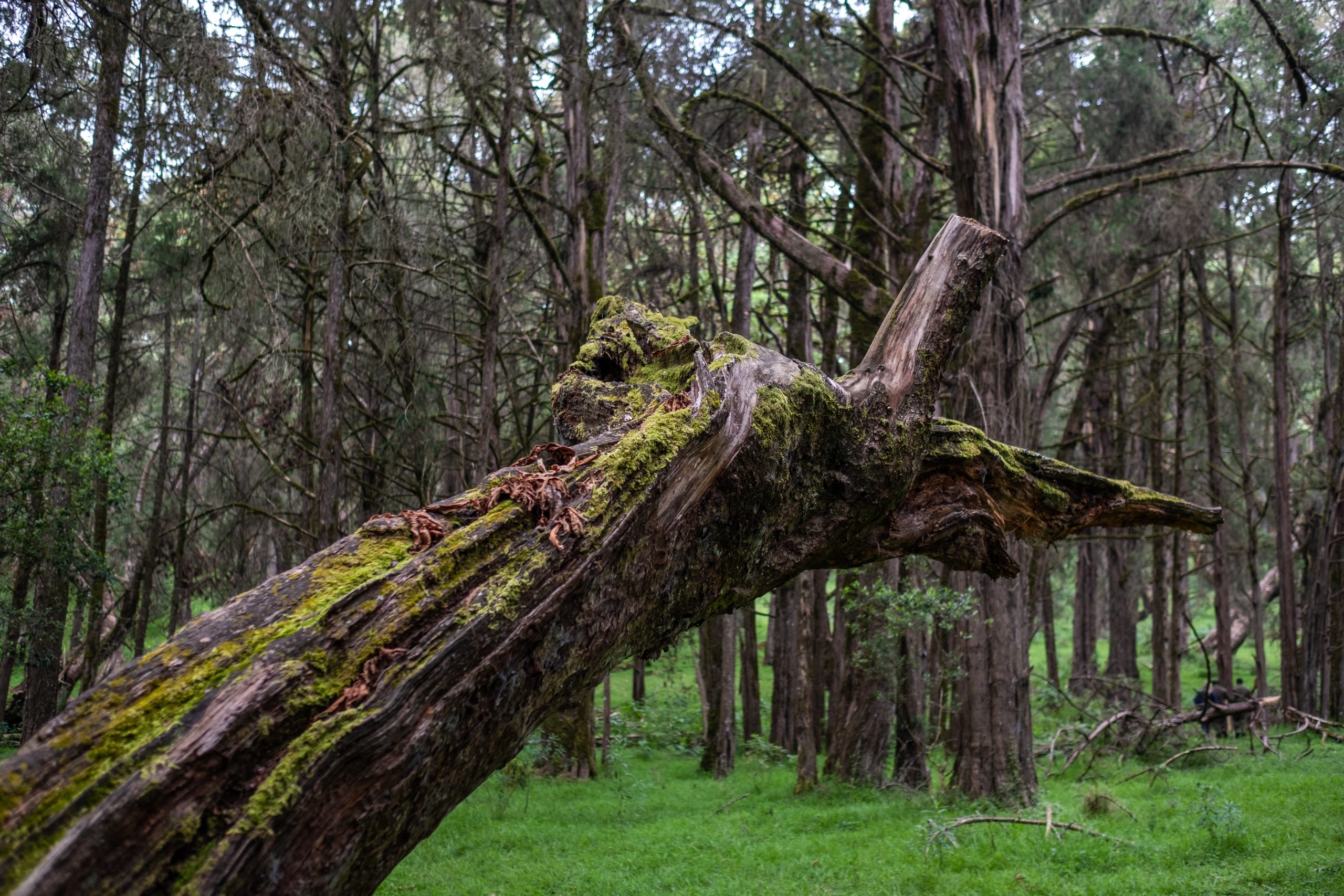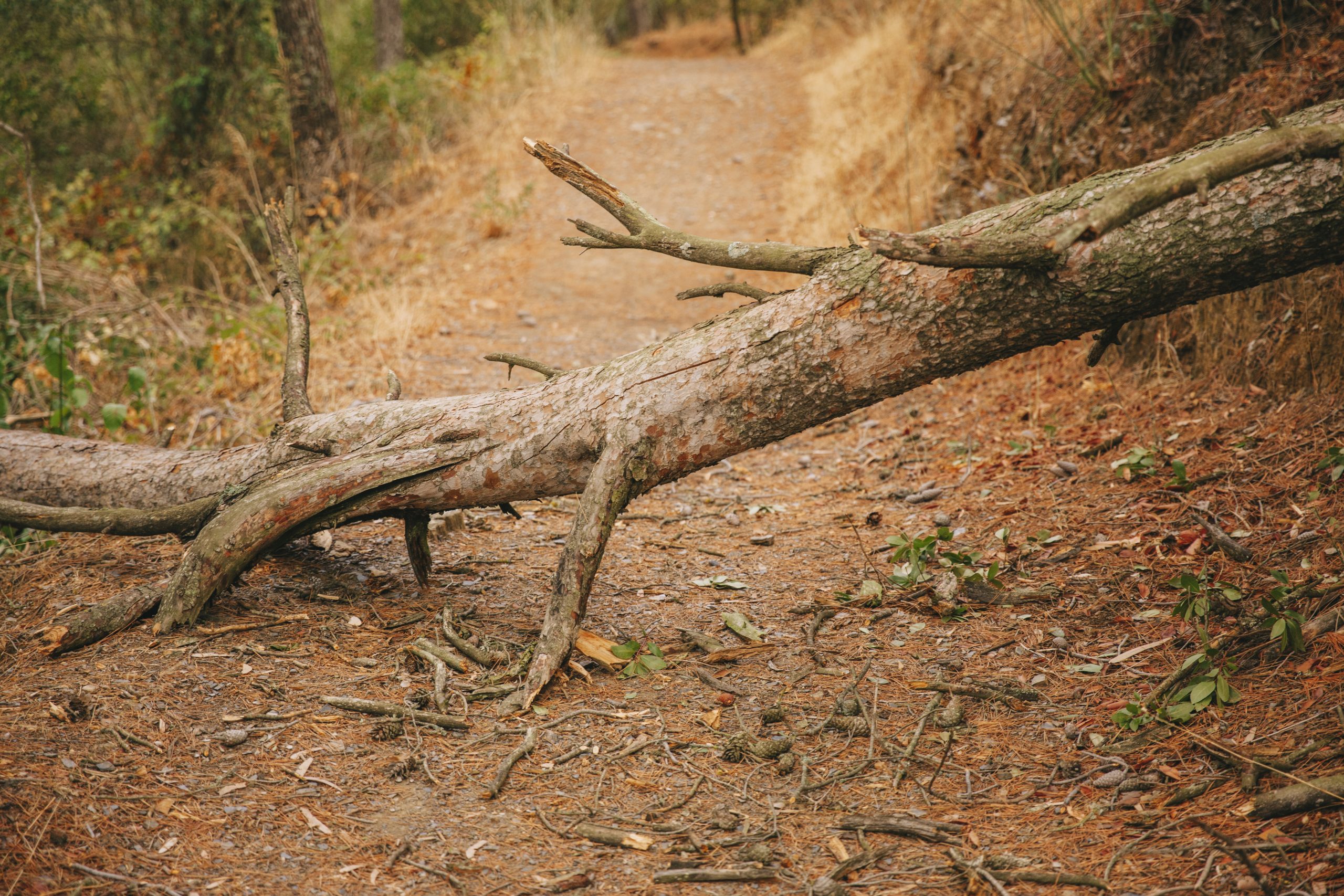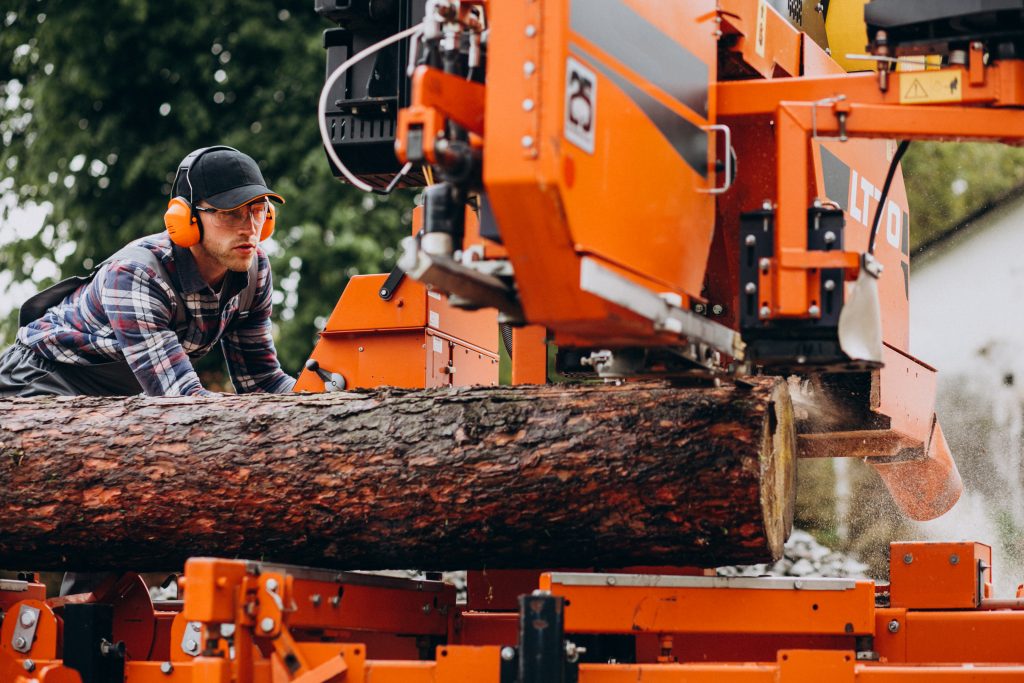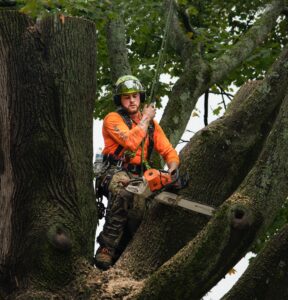BEST PRACTICES FOR MANAGING TREE DEBRIS NEAR ROADWAYS
BEST PRACTICES FOR MANAGING TREE DEBRIS NEAR ROADWAYS
Trees play a crucial role in improving soil organic matter decomposition through various scientific mechanisms. Here are some key ways in which trees contribute to this process:

- Leaf Litter and Organic Inputs: Trees shed leaves and other organic materials, which contribute to the organic matter content of the soil. These organic inputs, known as leaf litter, contain carbon compounds that serve as a food source for decomposer organisms in the soil.
- Rhizodeposition: Trees release organic compounds, such as sugars, amino acids, and organic acids, through their roots. This process, known as rhizodeposition, provides a source of energy and nutrients for soil microorganisms involved in decomposition.
- Root Exudates: Tree roots release exudates, including enzymes, organic acids, and other compounds. These exudates facilitate the breakdown of organic matter in the soil, enhancing decomposition processes.
- Microbial Activity: Trees support a diverse and active microbial community in the soil. Soil microorganisms, such as bacteria, fungi, and archaea, play a crucial role in decomposing organic matter by secreting enzymes that break down complex organic compounds into simpler forms that can be absorbed by plants.
- Soil Aggregation: Trees contribute to the formation of soil aggregates, which are small clusters of soil particles bound together. Soil aggregates create pore spaces that allow for better water infiltration, gas exchange, and movement of decomposer organisms. This facilitates the decomposition process by providing a favorable environment for microbial activity.
- Soil Moisture and Temperature Regulation: Trees provide shade and transpire water, creating a more favorable microclimate in the soil. Moderate soil moisture and temperature conditions support optimal microbial activity and decomposition rates.
- Mycorrhizal Associations: Many tree species form mutualistic relationships with mycorrhizal fungi. These fungi form a symbiotic association with tree roots, extending the root system and enhancing nutrient uptake. Mycorrhizal fungi also contribute to organic matter decomposition through their enzymatic activities.
- Earthworm Activity: Trees, especially those with dense leaf litter, can attract earthworms to the soil. Earthworms feed on decaying organic matter, facilitating its breakdown and nutrient cycling.
By promoting the decomposition of organic matter, trees contribute to the nutrient cycling and fertility of the soil. The organic matter decomposition process releases essential nutrients that become available to plants, supporting their growth and overall ecosystem productivity.
It’s important to note that the specific mechanisms and rates of organic matter decomposition can vary depending on tree species, soil conditions, climate, and other environmental factors. However, the overall contribution of trees to soil organic matter decomposition is well-established and underscores their importance in maintaining healthy and productive ecosystems.
Key Aspects of Emergency Tree Services
- Tree Removal: Emergency tree services involve the prompt and safe removal of fallen, leaning, or hazardous trees. Professionals use specialized equipment and techniques to dismantle or cut down trees in a controlled manner, minimizing the risk of damage to surrounding structures.
- Storm Damage Response: In the aftermath of severe storms, high winds, hurricanes, or tornadoes, emergency tree services address fallen trees, broken branches, and trees that pose an imminent threat to property or public safety.
- Utility Line Clearance: Fallen trees and branches can pose a significant risk to utility lines, including power lines and telephone cables. Emergency tree services involve safely removing trees and debris that are in contact with or near utility lines to prevent power outages, fires, or electrical hazards.
- Public Safety: When trees or branches block roadways, pathways, or access points, emergency services are needed to clear the obstruction and restore safe passage for pedestrians and vehicles.
- Structural Integrity: If a tree falls onto a building, vehicle, or other structures, emergency tree services assess the situation, stabilize the tree, and carefully remove it to prevent further damage and ensure safety.
- Hazardous Tree Identification: Arborists and tree professionals assess the structural integrity and health of trees to identify potential hazards. Trees with compromised structural integrity due to disease, decay, or other factors may be targeted for removal to prevent future emergencies.
- Quick Response: Emergency tree services require rapid response to prevent escalation of risks. Professionals are available around the clock to address urgent situations promptly.
- Safety Measures: Safety is paramount during emergency tree services. Professionals are equipped with proper personal protective equipment (PPE) and follow safety protocols to avoid accidents and injuries.
- Community Support: Emergency tree services often work in collaboration with local authorities, emergency response teams, and utility companies to coordinate efforts and ensure a comprehensive response.
Examples of Emergency Situations
- Fallen trees blocking roads or driveways
- Trees on the verge of collapsing onto structures or vehicles
- Trees leaning dangerously after a storm
- Trees entangled in utility lines
- Trees with branches that have broken or are at risk of falling
- Trees posing risks to public safety in public spaces
Overall, emergency tree services play a critical role in addressing immediate threats posed by trees in distress. Their expertise and rapid response help minimize risks, restore safety, and protect communities from potential hazards associated with fallen or damaged trees.
Importance of addressing tree-related emergencies promptly
Addressing tree-related emergencies promptly is of paramount importance due to the potential risks, dangers, and damages that can result from delayed or inadequate response. The urgency of addressing these emergencies stems from the need to ensure public safety, prevent property damage, and maintain the overall well-being of communities. Here’s why addressing tree-related emergencies promptly is crucial:

Public Safety
- Fallen or leaning trees can pose immediate dangers to pedestrians, vehicles, and structures. Addressing these hazards promptly helps prevent accidents, injuries, and even fatalities.
Property Protection
- Prompt response to tree-related emergencies can prevent trees from falling onto buildings, vehicles, power lines, and other structures, minimizing costly damage and repair expenses.
Infrastructure Preservation
- Fallen trees can damage roads, sidewalks, utility poles, and other infrastructure. Timely removal and mitigation efforts help preserve vital community infrastructure.
Rapid Recovery
- Addressing tree-related emergencies swiftly accelerates the recovery process after storms, ensuring that communities can resume normal activities sooner.
Prevention of Escalation
- A small issue with a tree, such as a cracked branch, can escalate into a major emergency if not addressed promptly. Taking early action prevents such situations from worsening.
Utility Line Safety
- Trees entangled in utility lines can cause power outages, fires, and electrical hazards. Quick response prevents disruptions in essential services and potential dangers.
Minimization of Secondary Risks
- Fallen trees or branches can obstruct roadways, impeding traffic flow and access for emergency responders. Timely removal restores access and facilitates emergency operations.
Community Resilience
- Prompt emergency tree services contribute to community resilience by minimizing disruptions and enhancing the ability of residents and businesses to recover swiftly from disasters.
Preservation of Ecosystem Health
- Timely interventions can prevent the spread of tree diseases, pests, or invasive species that could impact the health of other trees and ecosystems.
Legal and Liability Considerations
- Property owners and responsible parties have a legal duty to address tree-related hazards promptly. Failure to do so may lead to legal liabilities if accidents or damages occur.
Proactive Risk Management
- Addressing emergencies promptly aligns with proactive risk management strategies, reducing the likelihood of unforeseen accidents or incidents.
Community Confidence
- Swift response to emergencies demonstrates local authorities’ commitment to public safety and builds confidence within the community.
Addressing tree-related emergencies promptly is a critical responsibility for ensuring the safety and well-being of individuals, protecting property and infrastructure, and promoting the overall resilience of communities. Timely interventions minimize risks, mitigate damages, and contribute to a safer and more secure environment for everyone.
Potential Hazards and Risks Posed By Emergency Situations In Tree Services
Emergency situations in tree services can present a range of potential hazards and risks that require careful consideration and expert handling. These hazards can pose threats to both tree service professionals and the general public. Understanding these risks is crucial for effective planning, mitigation, and response during emergency tree service operations.
Here are some potential hazards and risks associated with emergency situations in tree services:
- Structural Instability: Fallen or damaged trees may have compromised structural integrity, making them prone to unexpected collapses during removal or pruning.
- Falling Limbs or Trees: While removing or pruning trees, there is a risk of limbs or the entire tree falling unexpectedly, endangering workers and bystanders.
- Electrical Hazards: Trees entangled in utility lines can pose electrocution risks to workers. Power lines can be energized and carry deadly currents.
- Equipment Malfunction: Chainsaws, ropes, cranes, and other equipment used in emergency tree services can malfunction, leading to accidents or injuries.
- Climbing Hazards: Climbing trees to perform emergency services presents the risk of falls, especially if workers are not properly trained or equipped with safety gear.
- Wildlife and Insects: Trees may be habitats for wildlife or infested with insects. Disturbing these can lead to bites, stings, or encounters with potentially dangerous animals.
- Traffic and Public Safety: Emergency tree service operations near roadways can disrupt traffic flow and pose risks to motorists and pedestrians.
- Weather Conditions: Working during adverse weather conditions such as rain, wind, or lightning can increase the risks associated with tree service operations.
- Improper Equipment Use: Inadequate or improper use of equipment, such as chainsaws or ropes, can result in accidents, injuries, or fatalities.
- Lack of Training and Experience: Workers without proper training and experience in emergency tree services may make critical errors that lead to accidents or unsafe practices.
About Murray, Utah
Murray is a city situated on the Wasatch Front in the core of Salt Lake Valley in the U.S. state of Utah. Named for territorial governor Eli Murray, it is the state's fourteenth largest city. According to the 2020 census, Murray had a population of 50,637. Murray shares borders with Taylorsville, Holladay, South Salt Lake and West Jordan, Utah. Once teeming with heavy industry, Murray's industrial sector now has little trace and has been replaced by major mercantile sectors. Known for its central location in Salt Lake County, Murray has been called the Hub of Salt Lake County. Unlike most of its neighboring communities, Murray operates its own police, fire, power, water, library, and parks and recreation departments and has its own school district. While maintaining many of its own services, Murray has one of the lowest city tax rates in the state.
Neighborhoods in Murray, Utah
Murray Oakes, Grant Park, Southwood Park, Murray Park, Murray Park Restrooms, Willow Pond Park, Neighborhood Veterinary Care
Things To Do in Murray, Utah
Bus Stops in Murray, Utah to Truco Services, Inc.
Bus Stop in Murray Central Station (Bay C) Murray, Utah to Truco Services, Inc.
Bus Stop in State St @ 4801 S Murray, Utah to Truco Services, Inc.
Bus Stop in Murray North Station Murray, Utah to Truco Services, Inc.
Bus Stop in State St @ 4949 S Murray, Utah to Truco Services, Inc.
Bus Stop in Murray Central Frontrunner/Trax Station Murray, Utah to Truco Services, Inc.
Bus Stop in Murray Blvd / Vine St (SB) Murray, Utah to Truco Services, Inc.
Bus Stop in State St @ 3925 S Murray, Utah to Truco Services, Inc.
Bus Stop in State St @ 4824 S Murray, Utah to Truco Services, Inc.
Bus Stop in State St @ 5223 S Murray, Utah to Truco Services, Inc.
Bus Stop in Murray Blvd / Allendale Dr (NB) Murray, Utah to Truco Services, Inc.
Bus Stop in Murray Blvd @ 5039 S Murray, Utah to Truco Services, Inc.
Bus Stop in State St @ 4721 S Murray, Utah to Truco Services, Inc.
Driving Directions in Murray, Utah to Truco Services, Inc.
Driving Directions from Woodruff Tree Trimming and Removal to 4640 Commerce Dr, Murray, UT 84107, USA
Driving Directions from Reliable Tree Care to 4640 Commerce Dr, Murray, UT 84107, USA
Driving Directions from Tree Pro-Tech to 4640 Commerce Dr, Murray, UT 84107, USA
Driving Directions from Prestige Tree And Landscape to 4640 Commerce Dr, Murray, UT 84107, USA
Driving Directions from Excellence Tree & Landscape to 4640 Commerce Dr, Murray, UT 84107, USA
Driving Directions from Amen Trees to 4640 Commerce Dr, Murray, UT 84107, USA
Driving Directions from Tim's Tree Care to 4640 Commerce Dr, Murray, UT 84107, USA
Driving Directions from Jordan Tree Service - Murray to 4640 Commerce Dr, Murray, UT 84107, USA
Driving Directions from Arbor Works to 4640 Commerce Dr, Murray, UT 84107, USA
Driving Directions from Diamond Tree Experts to 4640 Commerce Dr, Murray, UT 84107, USA
Driving Directions from Green Tree Arborist to 4640 Commerce Dr, Murray, UT 84107, USA
Driving Directions from TruCo Services to 4640 Commerce Dr, Murray, UT 84107, USA
Reviews for Truco Services, Inc. Murray, Utah
Emily Abercrombie
We had a great experience with TruCo! They were well priced, responsive and prompt. Michael was a pleasure to work with and gave us advice on which plants to put in where we took out our ugly old shrubs. I would highly recommend this company!!!
Michelle Turpin
TruCo Services gets 5 stars from us for customer service. We experienced a few issues with their services this last year and Rob Eccles in senior management, stepped in and immediately handled our issues. He was very committed to making sure they understood our expectations and would execute to make us happy.
Siobhan Billingsley
I work for a property management company and have the pleasure of working with Rob at a community in Sandy. He has been incredible to work with and always responds in a timely manner. He knows all the homeowners by name and address and is aware of all the "problem" areas when it comes to sprinklers. I never have to worry about following up with him because he always reaches out to provide me with an update. If you're looking to work with someone who takes pride in their job, is professional, and can solve the worst landscaping problems thrown your way, Rob is your guy. Thank you, Rob for all you do!
Jaime S.
We have used Truco at 2 of the complexes we manage, they have been great to work with. Good quality service, outstanding customer service with good communication. That's hard to find these days. I highly recommend them. Travis has been awesome to work with.
Jerusha Smart
We use TruCo for a majority of our properties and our home. While other landscaping companies we use come and go for various reasons like cost, communication issues, work performance, etc., TruCo is always consistent in price and work. Also, Rob is the best.

